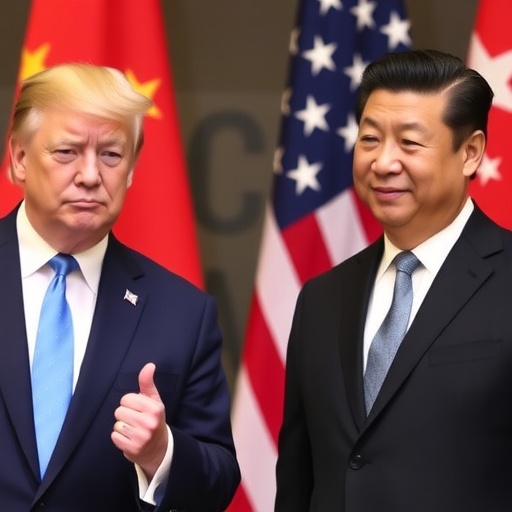Trump and Xi Jinping Gear Up for High-Stakes APEC Summit Meeting to Defuse US-China Trade War
In a move that could reshape global economic dynamics, US President Donald Trump and Chinese President Xi Jinping are scheduled to hold pivotal face-to-face talks at the Asia-Pacific Economic Cooperation (APEC) summit in South Korea next week. This high-profile encounter comes amid simmering US-China trade disputes, with tariffs on billions in goods still in place and new export restrictions threatening to reignite a full-blown trade war. Sources close to the White House indicate that the meeting aims to chart a path toward de-escalation, focusing on technology transfers, intellectual property rights, and the sensitive issue of Taiwan’s status.
The APEC summit, hosted in Busan, South Korea, from November 15-21, provides a neutral stage for the two leaders to address these flashpoints. Trump, who has long championed an ‘America First’ agenda, has repeatedly criticized China’s trade practices, imposing tariffs that have cost both economies dearly. Xi, navigating domestic economic pressures, seeks stability to bolster China’s recovery from pandemic-era slowdowns. With global supply chains still fragile, the world watches closely as these talks could either ease tensions or push US-China trade relations to the brink.
Reviving Stalled US-China Trade Negotiations
The upcoming meeting between Trump and Xi Jinping marks a critical juncture in the ongoing US-China trade saga, which has dominated headlines since 2018. Back then, the Trump administration slapped tariffs on over $360 billion worth of Chinese imports, citing unfair trade practices like forced technology transfers and state subsidies. China retaliated with duties on $110 billion of US goods, hitting American farmers and manufacturers hard. According to the Peterson Institute for International Economics, these tariffs have reduced US GDP by 0.2% annually and shaved 0.9% off China’s growth.
Recent developments have added urgency to the APEC summit. In October, the US tightened export controls on advanced semiconductors to China, aiming to curb Beijing’s military advancements. This move, part of the broader US-China trade friction, prompted China to restrict rare earth exports, essential for everything from electric vehicles to defense tech. ‘The tariffs and restrictions are like a dam holding back mutual prosperity,’ said Robert Lighthizer, Trump’s former trade representative, in a recent interview with CNBC. ‘This meeting could open the floodgates if both sides show goodwill.’
Preparatory talks between US and Chinese officials have been underway for weeks, with Treasury Secretary Janet Yellen emphasizing the need for ‘principled engagement.’ On the Chinese side, Vice Premier Liu He has signaled openness to dialogue, stating in a state media appearance that ‘cooperation benefits all, confrontation harms all.’ The APEC platform, involving 21 Pacific Rim economies, amplifies the stakes, as outcomes could influence regional trade pacts like the CPTPP.
Economists predict that a successful thaw in US-China trade could boost global GDP by up to 1.5%, per a World Bank report. However, failure might lead to further escalation, with Trump hinting at new tariffs if China doesn’t budge on subsidies for electric vehicles and solar panels. As delegates arrive in Busan, the air is thick with anticipation—will this be the reset button the world needs?
Tariffs Under the Microscope: Economic Toll and Reform Proposals
At the heart of the Trump-Xi discussions will be the thorny issue of tariffs, which have become synonymous with the US-China trade standoff. The current tariff regime, largely unchanged since the Phase One deal in 2020, imposes average rates of 19% on US imports from China and 21% on Chinese imports from the US. These measures were intended to level the playing field but have instead inflated costs for consumers and disrupted supply chains. A study by the National Bureau of Economic Research found that US households pay an extra $419 annually due to these tariffs, while Chinese exporters have lost market share to competitors in Vietnam and Mexico.
Trump has been vocal about maintaining pressure, tweeting last month, ‘China must stop ripping off America—tariffs are our strongest tool!’ Yet, with inflation lingering at 3.2% in the US, there’s growing bipartisan pressure to negotiate relief. Proposed reforms include phased reductions tied to verifiable commitments on intellectual property enforcement. China, facing its own export slump—down 8.5% year-over-year in September—has floated ideas for mutual tariff cuts in sectors like agriculture and machinery.
Experts like Chad Bown from the Peterson Institute argue that ‘targeted tariff relief could unlock $200 billion in bilateral trade flows.’ During the APEC summit, side sessions will delve into these mechanics, with South Korean hosts pushing for inclusive growth. One potential breakthrough: a ‘tariff holiday’ on green tech imports, aligning with both nations’ climate goals. But skeptics warn that without enforcement mechanisms, any deal could crumble, echoing the fragile Phase One agreement where China met only 57% of its purchase commitments.
The human cost is stark too. In the US Midwest, soybean farmers still grapple with lost Chinese markets, while in Guangdong province, factory closures have displaced thousands. As Trump and Xi Jinping sit down, the tariff debate will test their resolve to prioritize economics over politics.
Technology Controls and Taiwan: Beyond Trade into Geopolitics
While tariffs dominate headlines, the Trump-Xi meeting at the APEC summit will extend into deeper waters: technology controls and the Taiwan strait. US restrictions on exporting high-tech items like AI chips and quantum computing tech to China have escalated since the Biden era, with Trump vowing to ‘double down’ if re-elected. These controls, justified under national security pretexts, have bifurcated global tech supply chains, forcing companies like Apple and Nvidia to diversify away from China.
China views these as economic warfare, with Xi Jinping declaring in a speech to the Communist Party Congress that ‘self-reliance in science and technology is the only path to security.’ Retaliatory measures include bans on US firms like Micron from key markets. At APEC, negotiators may explore ‘trusted vendor’ lists to ease flows without compromising security—a delicate balance given espionage allegations on both sides.
Taiwan looms larger, adding geopolitical heat to US-China trade talks. The island’s semiconductor dominance, via TSMC, makes it a flashpoint; US support for Taiwan’s defense has irked Beijing, which claims the territory as its own. Recent US arms sales worth $2 billion have heightened tensions, with Chinese military drills encircling Taiwan in response. ‘Taiwan is non-negotiable in trade talks,’ a senior US official told Reuters anonymously, underscoring how APEC could bridge—or widen—this divide.
Analysts from the Council on Foreign Relations suggest that incremental steps, like joint AI governance frameworks, could build trust. Yet, with Trump’s unpredictable style—recalling his 2017 Mar-a-Lago summit with Xi that briefly thawed relations—the outcome remains uncertain. Stakeholders from Japan to Australia, attending APEC, hope for de-escalation to stabilize the Indo-Pacific.
Global Ripples: How APEC Outcomes Could Reshape World Economy
The APEC summit isn’t just a bilateral affair; its reverberations will echo across global markets. Investors are already positioning for volatility, with the S&P 500 dipping 1.2% on news of the meeting. A positive Trump-Xi accord could lift Asian indices by 5-7%, per Bloomberg estimates, while escalation might trigger a ‘risk-off’ selloff reminiscent of 2019’s trade war lows.
Supply chain realignments are accelerating: US firms have repatriated $1 trillion in investments since 2018, per Reshoring Institute data, but many remain tethered to China for efficiency. A deal easing US-China trade barriers could reverse this ‘decoupling’ trend, benefiting multinationals and emerging markets alike. Conversely, prolonged tariffs risk inflating commodity prices, exacerbating food insecurity in developing APEC nations like Indonesia and Peru.
Environmental angles are emerging too. Both leaders have touted green initiatives—Trump’s infrastructure bill includes clean energy, while Xi’s ‘dual carbon’ goals aim for peak emissions by 2030. APEC side deals on sustainable trade could harmonize standards, potentially unlocking $100 billion in low-carbon exports. Labor leaders, however, caution against rushed pacts that sideline workers’ rights.
As the summit unfolds, multilateral forums like the WTO will monitor progress. Early indicators from Busan suggest guarded optimism, with preliminary agreements on fisheries subsidies hinting at broader cooperation.
Looking ahead, the Trump-Xi dialogue sets the tone for 2024’s geopolitical landscape. Success might pave the way for a Phase Two trade deal, fostering innovation-sharing and economic resilience. Failure, however, could entrench divisions, prompting allies to choose sides in a fragmented world order. With delegates converging, the next week promises to be a defining moment for US-China trade and beyond.










